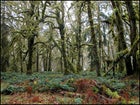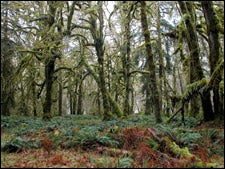For most people, when Old Man Winter rears his frosty head, the concept of wilderness transforms from the great beyond to either their fireplace or their favorite ski resort. For the hearty backpacker, of course, this means the weekend crowds that can choke the trails during the high season are populated by the forest’s wilder inhabitants, which is just perfect.
Olympic National Park
 NOT IN KANSAS ANYMORE: The rainforests of Olympic National Park
NOT IN KANSAS ANYMORE: The rainforests of Olympic National ParkSince you didn’t ask about backpacking in snow, I’ll assume you’re anxious to find trails that don’t require snowshoes. Lucky for you, Washington state has loads of spectacular lowland routes across the state’s diverse coastal shores, national parks, and rainforests. But for my money, there’s only one choice: Olympic National Park.
Located just two and a half hours west of Seattle and home to 7,980-foot Mount Olympus, Olympic National Park is adjacent to 73 miles of protected Pacific coastal shores and was designated as 95% wilderness by Congress in 1988. At almost a million acres, there’s more than enough room for backpackers, hikers, and everyone in between. Yet, unpredictable winter storms render many trails impassable, leaving over half of the park inaccessible. So plan your trips accordingly, leaving the 60 glaciers in the park for summer exploration while tackling the lower-elevation spots during the off-season.
Don your warmest, quickest-drying layers, pack a fly rod, and hit the Duckabush River Trail. The well-worn path follows its namesake and extends 23 miles into the high country, but you’ll likely only get five, maybe ten miles in before hitting the snow line, so consider setting up a base camp and head out on day hikes. The trail begins in second-growth forest and gradually climbs alongside boulders covered in moss, like swatches of untouched lime green shag carpet from 1973. Hamstring-burning hills await at mile 1.2 (Little Hump) and a couple miles further (Big Hump). You’ll be rewarded for your heart-pumping efforts with stellar views of the Duckabush Valley and Hood Canal after the latter climb. The trail drifts towards old growth forest, but first descends upon Five Mile Camp (1,300 feet) where the trail meets the banks of the roaring, glacier-fed Duckabush River. A few campsites have been established, as it’s the perfect spot to catch supper for the evening (plan on trout). Douglas firs and other evergreens provide a protective canopy overhead, but you’ll still need additional weather barriers, such as tarps, when setting up camp. Beginning at an elevation of 440 feet, the trail continues all the way up to 5,000-foot O’Neil Pass. Upper Duckabush begins another 12 miles (2,695 feet) from Five Mile Camp, and marks the point where steeper climbs become more frequent. To get there, drive 22 miles north of Hoodsport on Highway 101 and turn on Duckabush River Road (USFS #2510). You’ll reach the trailhead after approximately six miles.
A visit to the rainforest on the western side of the park is a definite must. The Hoh River Trail offers access to Blue Glacier and is one of the park’s most popular off-season rainforest trails. Through the thick canopy of towering cedar, spruce, and evergreen trees, it may seem as if you’ve slipped a few thousand miles and a whole continent south. About five and a half miles in—the half-way point to Lewis Meadow and a good spot for lunch—you’ll find the Happy Four Shelter. Make your way another three and a half miles to the Olympus Guard Station, where you’ll find a suitable bunkhouse with wooden platform beds. Or, if you prefer to pitch a tent, continue another two miles and set up camp in Lewis Meadow at the base of Mount Olympus. While hiking and camping, keep an eye out for Roosevelt elk; Olympic National Park is home to the largest unmanned herd in the States. To get to the trailhead, take Highway 101 14 miles south of Forks to Hoh Road and follow 18.5 miles to the end.
But if you’re looking for one of the northwest’s rarest adventures, make your way to the wild Pacific coastline. Located on the westernmost side of Olympic National Park, Rialto Beach is base camp for a 15.5-mile one-way beach hike. During the winter months, storms on the Pacific are considerably more intense and tides are higher. That said, coastal storms can exhibit rare, stunning examples of nature’s power, generating wave after shore-pounding wave. Tide pools, sea otters, and even gray whales are often visible from vantage points along the shore. Camping areas are located at Cedar Creek (6.8 miles in), Norwegian Memorial (mile 7.5), and Sand Point (15.5 miles in) along the coast. Take Highway 101 to Rialto Beach Road and follow it 13 miles to the end.
But keep this in mind: While the lower-elevation sites should keep you out of the snow—but this is the Pacific Northwest; you may be free of the white stuff, but expect rain and mud. Lots of mud. Take the Hoh River Trail. It starts at an elevation of 600 feet and gains just a mere 400 feet after 11 miles and has plenty of mud bogs and places where standing water can collect. Ranger stations, typically positioned at trailheads, always offers the most current trail conditions. Then again, if you’re already an experienced warmer-weather hiker in Washington, mud and rain probably don’t qualify as a real deterrent. So dress warm and have a blast.
–Amy A. Clark

